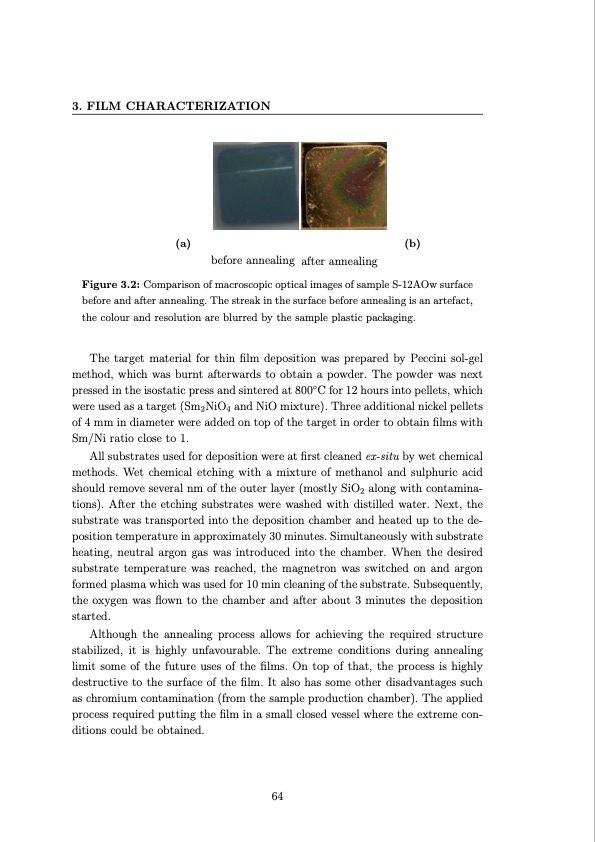
PDF Publication Title:
Text from PDF Page: 085
3. FILM CHARACTERIZATION (a) before annealing after annealing Figure 3.2: Comparison of macroscopic optical images of sample S-12AOw surface before and after annealing. The streak in the surface before annealing is an artefact, the colour and resolution are blurred by the sample plastic packaging. The target material for thin film deposition was prepared by Peccini sol-gel method, which was burnt afterwards to obtain a powder. The powder was next pressed in the isostatic press and sintered at 800◦C for 12 hours into pellets, which were used as a target (Sm2NiO4 and NiO mixture). Three additional nickel pellets of 4 mm in diameter were added on top of the target in order to obtain films with Sm/Ni ratio close to 1. All substrates used for deposition were at first cleaned ex-situ by wet chemical methods. Wet chemical etching with a mixture of methanol and sulphuric acid should remove several nm of the outer layer (mostly SiO2 along with contamina- tions). After the etching substrates were washed with distilled water. Next, the substrate was transported into the deposition chamber and heated up to the de- position temperature in approximately 30 minutes. Simultaneously with substrate heating, neutral argon gas was introduced into the chamber. When the desired substrate temperature was reached, the magnetron was switched on and argon formed plasma which was used for 10 min cleaning of the substrate. Subsequently, the oxygen was flown to the chamber and after about 3 minutes the deposition started. Although the annealing process allows for achieving the required structure stabilized, it is highly unfavourable. The extreme conditions during annealing limit some of the future uses of the films. On top of that, the process is highly destructive to the surface of the film. It also has some other disadvantages such as chromium contamination (from the sample production chamber). The applied process required putting the film in a small closed vessel where the extreme con- ditions could be obtained. 64 (b)PDF Image | Investigation of metal-insulator transition in magnetron sputtered samarium nickelate thin films

PDF Search Title:
Investigation of metal-insulator transition in magnetron sputtered samarium nickelate thin filmsOriginal File Name Searched:
Bilewska_Investigation_of_metal_insulator_transition_in_magnetron_sputtered_samarium.pdfDIY PDF Search: Google It | Yahoo | Bing
Sulfur Deposition on Carbon Nanofibers using Supercritical CO2 Sulfur Deposition on Carbon Nanofibers using Supercritical CO2. Gamma sulfur also known as mother of pearl sulfur and nacreous sulfur... More Info
CO2 Organic Rankine Cycle Experimenter Platform The supercritical CO2 phase change system is both a heat pump and organic rankine cycle which can be used for those purposes and as a supercritical extractor for advanced subcritical and supercritical extraction technology. Uses include producing nanoparticles, precious metal CO2 extraction, lithium battery recycling, and other applications... More Info
| CONTACT TEL: 608-238-6001 Email: greg@infinityturbine.com | RSS | AMP |